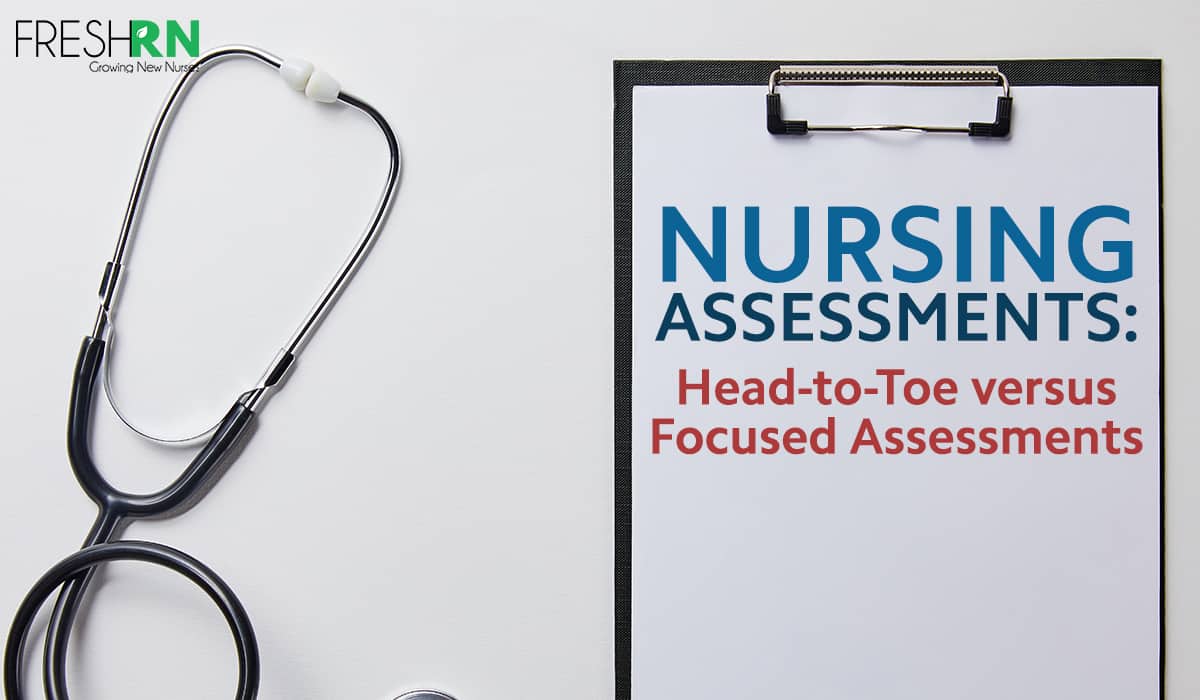Head-to-Toe Nursing Assessments versus Focused Assessments

What is Included in a Head-to-Toe Assessment?
During a head-to-toe assessment, the nurse evaluates the patient’s overall health status by systematically examining each body system, from head to toe. It is important to move from head-to-toe, otherwise you can easily miss steps. Pro-tip: It’s helpful for the nurse to be aware of abnormal assessment findings from the previous nurse prior to completing their head-to-toe assessment, as well as know penitent medical history and any current issues that could impact their findings to add context. The findings from the previous nurse are often communicated during nursing report. The remaining details are often found in the patient’s chart. Finally, it is helpful to know what the patient’s hemodynamic status is (most recent vital signs) prior to completing the assessment. All of these details help the nurse to establish a baseline for the patient’s health status, identify potential problems, and develop an appropriate care plan.Neurological system
The nurse will assess the patient’s mental status, reflexes, and sensory function, as well as checking for any signs of neurological deficits. I discuss full neuro assessments more in-depth here.Head and neck
The nurse will assess the patient’s eyes, ears, nose, mouth, throat, and neck for any abnormalities or signs of illness. This includes checking for jugular vein distention, ensuring the mucous membranes are not dry or pale, that swallowing is not impaired.Chest and lungs / respiratory system
The nurse will assess the patient’s respiratory status by listening to breath sounds, checking for chest expansion, and observing for any signs of respiratory distress and noting the work of breathing. Knowing the patient’s oxygen saturation is helpful when assessing their respiratory status, as well as what their oxygen requirements are and if that has changed recently (for example, if they were only 2L nasal cannula for the last two days and now they’re on 5L to maintain the same oxygen saturation).Heart and vascular system
The nurse will assess the patient’s heart rate, rhythm, and blood pressure, as well as checking for any signs of peripheral vascular disease. This includes listening to their heart sounds, checking for edema in their extremities, and assessing peripheral pulses (radial, dorsalis pedis, posterior tib). I discuss cardiac assessments in depth here, and have a checklist you can download here.Abdomen / gastrointestinal system
The nurse will assess the abdomen by first listening to bowel sounds in all four quadrants (here’s my fav stethoscope). Then, the nurse will palpate the abdomen and note any tenderness and inquire about recent bowel patterns and challenges.Genitourinary system
The nurse will assess the patient’s urinary output, noting if the patient is voiding normally. Nurses do not routinely inspect the genitals unless it is specifically indicated (for example, if the patient recently had a urological procedure or has a urinary catheter in place). If the patient has voided, the nurse will assess the color, clarity, amount, and odorOrder Now